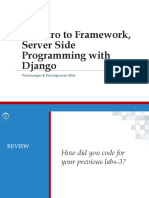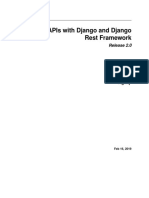Django Workflow: Step-by-Step
1. Client Sends an HTTP Request
What happens: A user interacts with a web page or an application, which sends an HTTP request
(like clicking a button or typing a URL). This request can either be a GET (to fetch data) or POST (to
submit data) request, among others. For example, if you visit http://localhost:8000/students/list/, the
browser sends a GET request to that URL.
What does it look like: The request typically contains:
- URL: Where the request is sent (e.g., /students/list/).
- Headers: These could include things like content type (JSON, HTML) or authentication tokens.
- Body: If it's a POST request, it can contain form data, JSON, etc.
2. URLconf (in urls.py) Matches the Request to the Correct View
What happens: Django needs to figure out which part of the application should handle this request.
It uses URLconf (URL configuration), which is a set of URL patterns defined in your urls.py file. This
is where Django maps incoming requests to specific views or functions.
How Django does this:
The request URL (e.g., /students/list/) is matched against URL patterns defined in the urls.py files.
Each pattern corresponds to a specific view that handles that request.
Example of urls.py (root and app level):
# student_management/urls.py (root URLconf)
from django.urls import path, include
urlpatterns = [
path('students/', include('students.urls')),
]
�# students/urls.py (app-level URLconf)
from . import views
urlpatterns = [
path('list/', views.student_list, name='student_list'),
Here, the request http://localhost:8000/students/list/ would match the student_list view in
students/views.py.
What it looks like: In this example, if a client visits /students/list/, it will match views.student_list.
3. View Processes the Request
What happens: After Django routes the request to the appropriate view, the view is responsible for
processing the request and preparing the response.
Steps in the view:
- Token Validation (if applicable): If the request requires authentication (e.g., accessing a private
API), the view may check for an access token (JWT, OAuth token, etc.). If the token is valid, the
request continues; otherwise, Django will return a 401 Unauthorized error.
- Database Interaction: The view might interact with the database using Django models. For
example, it can query the database for data (e.g., fetching a list of students).
- Serialization: If the response is data (e.g., JSON), Django serializes the data from Python objects
to a format suitable for the response (JSON, XML, etc.).
Example of the view:
# students/views.py
from django.http import JsonResponse
from .models import Student
from .serializers import StudentSerializer
def student_list(request):
� students = Student.objects.all() # Fetching all students from the database
serializer = StudentSerializer(students, many=True) # Converting data to JSON
return JsonResponse(serializer.data, safe=False) # Returning the data as a JSON response
What it looks like: The client might receive a response like:
{"id": 1, "name": "John Doe", "age": 21, "enrollment_date": "2020-09-15"},
{"id": 2, "name": "Jane Doe", "age": 22, "enrollment_date": "2021-01-20"}
What happens in a non-API scenario: If the view returns an HTML page, Django will render the
corresponding template and return HTML to the browser.
4. Middleware May Process the Request and Response
What happens: Middleware is a layer of code that runs during the request-response cycle and can
process requests before they reach the view, and responses before they are sent to the client.
What middleware can do:
Before the view is called:
- Handle sessions (e.g., saving and retrieving session data).
- Perform authentication checks (e.g., checking if the user is logged in or has permission to access
the view).
- Handle CSRF protection (ensuring the request is legitimate and comes from a trusted source).
After the view returns a response:
- Modify the response (e.g., adding headers, logging, etc.).
- Handle gzip compression (for reducing response size).
Example of a middleware:
# student_management/settings.py
MIDDLEWARE = [
� 'django.middleware.security.SecurityMiddleware',
'django.contrib.sessions.middleware.SessionMiddleware',
'django.middleware.common.CommonMiddleware',
'django.middleware.csrf.CsrfViewMiddleware',
'django.contrib.auth.middleware.AuthenticationMiddleware',
'django.contrib.messages.middleware.MessageMiddleware',
'django.middleware.clickjacking.XFrameOptionsMiddleware',
What happens: If the middleware detects an issue (e.g., missing authentication), it might block the
request and return a specific response. If everything is fine, the request is passed to the view, and
the response generated by the view will pass through the middleware before being sent to the client.
5. Response is Returned to the Client
What happens: After processing the request, Django prepares the response. This could be HTML
for a web page, JSON for an API, or even other formats like XML, depending on how the view is set
up.
How Django prepares the response:
- If it's a regular HTML response: The view might render a template using render() or HttpResponse,
and return it to the client.
- If it's an API response: The view might use JsonResponse or Response (from Django Rest
Framework) to return JSON data to the client.
- If there's an error (e.g., 404 Not Found): Django will generate an error page, or an error response
with the appropriate status code and message.
Example Response (HTML):
<html>
<body>
� <h1>Student List</h1>
<ul>
<li>John Doe</li>
<li>Jane Doe</li>
</ul>
</body>
</html>
Example Response (JSON):
"status": "success",
"data": [
{"id": 1, "name": "John Doe", "age": 21},
{"id": 2, "name": "Jane Doe", "age": 22}
How the Client Sees It
Once the response is prepared, it is sent back to the client (the browser or API client). For an HTTP
request like a GET request to /students/list/, the client might receive:
- A web page (if it's a web request) displaying a list of students, or
- JSON data (if it's an API request) that contains the list of students in a structured format.
Final Flow Recap
Client Request -> Client sends a request (e.g., via a browser or API client).
URL Resolution -> Django matches the URL to a view using urls.py.
View Handling -> The view processes the request, validates tokens (if needed), interacts with the
�database, and prepares data.
Middleware -> Middleware can process the request and response, for example, validating sessions
or adding headers.
Response to Client -> Django returns a response, either HTML or JSON, depending on the view and
the type of request.
This is the step-by-step process Django follows to handle requests and responses. Each part of the
cycle is crucial to ensure the request is properly authenticated, data is correctly processed, and the
appropriate response is delivered


























































